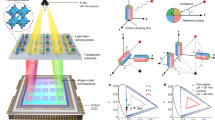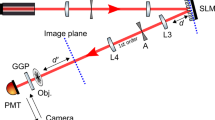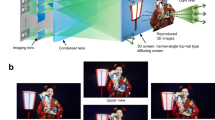Abstract
THE disadvantage of the ‘solid-image’ microscope described by Gregory and Donaldson1, as they point out, is that objects are seen through a relatively intense haze of background light, rather as if they were immersed in milk. There is a fairly straightforward way around this difficulty, though it entails a loss of some of the elegant simplicity of Gregory and Donaldson's instrument. During 1948–49 I devised and built at King's College a 3-dimensional scanning microscope on the same basic principle2, which was described briefly in a report on university research in physics in 19493 and exhibited at the College conversazione in that year. The slide carrier was vibrated in depth between 10 and 20 times a second with a saw-tooth motion, by means of a linear electromagnetic servo. The object, however, was scanned laterally by a flying spot on a cathode-ray tube, and the signal detected by a photomultiplier, exactly as in the 2-dimensional ‘flying spot microscope’ later (and apparently independently) described by Roberts and Young4 of University College, London. The three deflecting voltages and the photomultiplier signal were supplied to a 3-dimensional protective cathode-ray tube display of the type devised for use in radar and electronic computing5, so that a ‘solid’ representation of the object appeared on the screen and could be rotated at will by calibrated controls which enabled angles to be read directly.
This is a preview of subscription content, access via your institution
Access options
Subscribe to this journal
Receive 51 print issues and online access
$199.00 per year
only $3.90 per issue
Buy this article
- Purchase on Springer Link
- Instant access to full article PDF
Prices may be subject to local taxes which are calculated during checkout
Similar content being viewed by others
References
Gregory, R. L., and Donaldson, P. E. K., Nature, 182, 1434 (1958).
MacKay, D. M., Brit. Prov. Pat. Spec. 844/49.
Teegan, J. A., BEAMA J., 378 (1949).
Roberts, F., and Young, J. Z., Proc. Inst. Elect. Eng., 99, IIIA, 747 (1952).
Parker, E., and Wallis, P. R., J. Inst. Elect. Eng., 95, III, 371 (1948). MacKay, D. M., Electronic Eng., 248 (July) and 281 (Aug. 1949).
MacKay, D. M., Brit. Pat. No. 592,372 (1947); Electronic Eng., 284 (July 1950).
Author information
Authors and Affiliations
Rights and permissions
About this article
Cite this article
MACKAY, D. A ‘Solid-Image’ Microscope. Nature 183, 246–247 (1959). https://doi.org/10.1038/183246b0
Issue Date:
DOI: https://doi.org/10.1038/183246b0
Comments
By submitting a comment you agree to abide by our Terms and Community Guidelines. If you find something abusive or that does not comply with our terms or guidelines please flag it as inappropriate.



